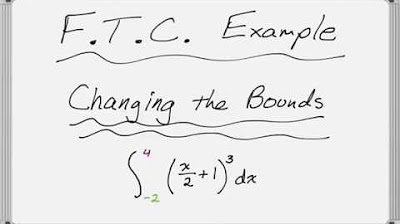_-substitution: definite integrals | AP Calculus AB | Khan Academy
TLDRThe video script focuses on demonstrating the application of u-substitution in solving definite integrals, specifically the integral of 2x times x squared plus one to the third power from x equals one to x equals two. The instructor explains the process of recognizing when to use u-substitution, setting up the substitution with u as x squared plus one, and transforming the integral into one with respect to u. The video also discusses two methods for handling the bounds of integration: either changing the bounds to reflect the new variable u or evaluating the indefinite integral and then applying the bounds. The end result is the evaluation of the integral, showcasing the power of u-substitution in simplifying complex integrals.
Takeaways
- 📚 The video focuses on practicing the application of u-substitution in solving definite integrals.
- 🌟 Recognizing when to use u-substitution is crucial, often indicated by a relationship between the integrand and its derivative.
- 🔄 The substitution u = x^2 + 1 is used, with du = 2x dx, to transform the integral into a form that is easier to evaluate.
- 📈 The definite integral involves the function 2x times (x^2 + 1)^3 from x=1 to x=2.
- 🎢 The bounds of integration must be adjusted when using u-substitution, changing from x=1 to x=2 to u=2 to u=5.
- 🧠 Understanding the change in bounds is essential, as it reflects the new variable of integration (u).
- 📊 The antiderivative of the transformed integral is (u^4)/4, which is evaluated at the new bounds of u=5 and u=2.
- 🤝 Another approach is to solve the indefinite integral in terms of x using u-substitution and then evaluate at the original bounds.
- 🔢 The final result is obtained by evaluating (x^2 + 1)^4/4 at x=2 and subtracting it from the same expression evaluated at x=1.
- 🔄 Back-substitution is used to convert the result back into the original variable (x) for a clear interpretation.
- 🎯 Both methods, changing bounds or evaluating the indefinite integral, yield the same result when correctly applied.
Q & A
What is the main topic of the video?
-The main topic of the video is practicing the application of u-substitution to solve definite integrals.
What integral is being solved in the example?
-The integral being solved is ∫ from x=1 to x=2 of (2x * (x^2 + 1)^3) dx.
How is u-substitution recognized in this problem?
-U-substitution is recognized by the presence of x^2 + 1 in both the integrand and its derivative (2x), suggesting that a substitution can be made by setting u = x^2 + 1.
What is the differential form of the substitution?
-The differential form of the substitution is du = 2x dx.
How are the bounds of integration adjusted when using u-substitution for a definite integral?
-The bounds of integration are adjusted by substituting the original x values into the u equation. When x=1, u=2, and when x=2, u=5, so the bounds become from u=2 to u=5.
What is the antiderivative of u to the third power?
-The antiderivative of u to the third power is (u^4)/4.
How can the definite integral be evaluated using the antiderivative?
-The definite integral can be evaluated by substituting the bounds of integration into the antiderivative, which gives ((5^4)/4 - (2^4)/4).
What is the alternative method to solving the integral mentioned in the video?
-The alternative method is to evaluate the indefinite integral in terms of x using u-substitution as an intermediary step, then back-substitute and evaluate at the bounds.
What is the result of the definite integral using the u-substitution method?
-The result of the definite integral is ((5^4)/4 - (2^4)/4), which simplifies to (625 - 16)/4 or 609/4.
How does back-substitution help in evaluating the indefinite integral?
-Back-substitution helps by replacing the u variable with its equivalent in terms of x (u = x^2 + 1), allowing the evaluation of the antiderivative at the original integration bounds.
What is the significance of u-substitution in solving integrals?
-U-substitution is significant because it simplifies complex integrals, especially those that are products of a function and its derivative, making them easier to evaluate and solve.
Outlines
📚 Introduction to u-Substitution in Definite Integrals
This paragraph introduces the concept of applying u-substitution to definite integrals, specifically focusing on the integral of 2x times the quantity x squared plus one to the third power, from x equals one to x equals two. The instructor explains the rationale behind using u-substitution by identifying the derivative of the function, which mirrors part of the original integrand. The substitution is set with u as x squared plus one, and its derivative with respect to x as 2x, leading to the transformation of the integral into one in terms of u. The paragraph also addresses the change in bounds of integration when switching from x to u, demonstrating how to adjust the limits from one to two in terms of u by solving for u when x equals one and two. The goal is to evaluate the definite integral using u-substitution, either by changing the bounds or by evaluating the indefinite integral and then applying the bounds.
🔍 Evaluating Definite Integrals using u-Substitution
In this paragraph, the focus is on the actual evaluation of the definite integral using the u-substitution method. The instructor first explains how to change the bounds of integration from x values to u values, which are two and five, corresponding to x equals one and two, respectively. The integral is then rewritten in terms of u, and the antiderivative of u to the third power is found, which is u to the fourth over four. The evaluation of this antiderivative at the bounds of integration (five and two) is described, leading to the result of five to the fourth over four minus two to the fourth over four. The paragraph also discusses an alternative approach, which involves solving the indefinite integral in terms of x and then back-substituting the bounds of integration. This method also leads to the same result, demonstrating the versatility of u-substitution in evaluating definite integrals.
Mindmap
Keywords
💡u-substitution
💡definite integral
💡antiderivative
💡bounds of integration
💡derivative
💡integration
💡indefinite integral
💡substitution
💡dx
💡algebraic simplification
💡back-substitution
Highlights
The video focuses on practicing the application of u-substitution to definite integrals.
The integral given as an example is ∫(x^2 + 1) * x^3 dx from x=1 to x=2.
The recognition of the derivative of x^2 + 1 (2x) matches a term in the integral, indicating the potential for u-substitution.
The substitution u = x^2 + 1 is made, with du = 2x dx.
The integral is rewritten in terms of u, as ∫u^3 du.
The bounds of integration must be adjusted for the definite integral after applying u-substitution.
When x=1, u equals 2, and when x=2, u equals 5, thus the bounds of integration in terms of u are from 2 to 5.
The definite integral can be evaluated by finding the antiderivative of u^3 and applying the bounds of 2 to 5.
The antiderivative of u^3 is u^4/4, and the definite integral is evaluated as (5^4/4 - 2^4/4).
An alternative approach is to solve the indefinite integral in terms of x using u-substitution as an intermediate step.
The indefinite integral is evaluated at x=2 and x=1 after applying u-substitution.
Back-substitution is used to replace u with x^2 + 1 in the result of the indefinite integral.
The final result is the same regardless of the method used, demonstrating the validity of u-substitution in evaluating definite integrals.
The process illustrates the importance of understanding when and how to apply u-substitution effectively.
The video provides a clear and detailed explanation of u-substitution, making it accessible for learners.
Transcripts
Browse More Related Video

_-substitution: definite integral of exponential function | AP Calculus AB | Khan Academy

Fundamental Theorem of Calculus: Changing the Bounds with u-Substitution

Lesson 11 - Integration By Substitution (Calculus 1 Tutor)

Integral of sinx cosx

Definite Integrals from Graphs (Part 2 of 3) - U-Substitution

_-substitution intro | AP Calculus AB | Khan Academy
5.0 / 5 (0 votes)
Thanks for rating: